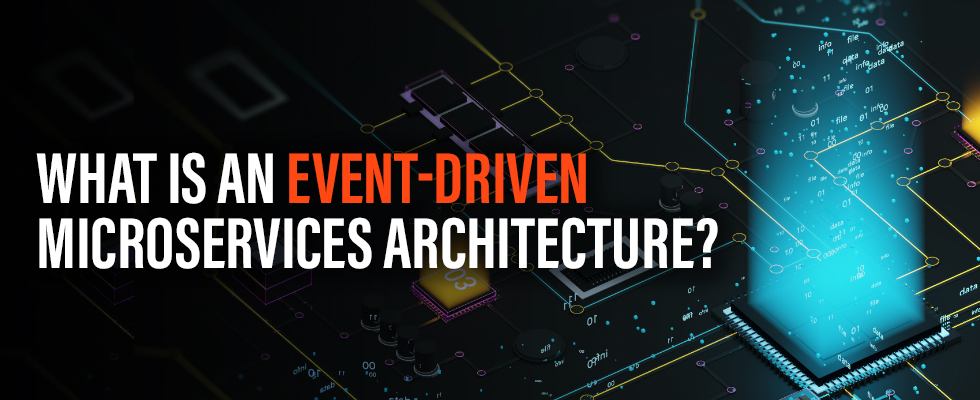An event-driven microservices architecture is an approach to software development where decoupled microservices are designed to communicate with one another when events occur.
These architectures are comprised of three critical features:
- Event producers, which detect and send events to routers when they occur,
- Event routers, which analyze events and determine where to send them, and
- Event consumers, which process events, handle them, and complete the action (e.g., updating a data warehouse to reflect current inventory levels).
Table Of Contents
What is an event?
As the name suggests, an event occurs when some specific action takes place. This event could be a shipment’s status update, a user posting a message on social media, a consumer entering in their credit card information to finalize a transaction, or a webhook pulling information from a monitoring platform.
Increasingly, engineering teams are building applications with event-driven architectures to improve operational agility and develop highly performant applications that can respond to new events in real time.
To make the most out of these applications, developers are moving away from monolithic applications and creating software with microservices.
What are microservices?
Microservices are smaller software components responsible for one specific function, such as processing a credit card payment.
In the past, engineering teams would build monolithic applications, which contained all of the logic and functionality a solution needed to work. While monolithic software had its advantages — it’s easier to debug and deploy — it also had (or has, as it’s still being used) its fair share of challenges.
For example, if you needed to change one feature of a monolithic application, it takes more time because coding is more complex, with more moving parts. Additionally, monolithic applications are harder to scale because you can’t scale individual features. Further, developers can’t add new technologies to monolithic applications; they’re locked into whatever’s already there.
Microservices solve these problems. While microservices require teams to maintain many more services than monoliths, each service is self-contained. As a result, it’s easier to operate with agility, teams can scale single components easily, and development lifecycles are accelerated. Plus, it’s easy to iterate and test new features; in the event, a new feature doesn’t work as designed, teams can easily roll it back and revert to the previous state.
On top of this, microservices are also highly reliable. Teams can update specific microservices without worrying about bringing the entire application down. Plus, engineers can incorporate new tools and technologies as they desire; and aren’t locked into existing tech.
Benefits of an event-driven architecture
An event-driven architecture ensures applications can quickly respond to state changes as users, bots, and webhooks perform specific actions. In today’s age of ubiquitous connectivity and lightning-fast networks, it comes as no surprise that more and more engineering teams are using event-driven architectures to construct their applications.
At a high level, event-driven architecture delivers a number of benefits to developers, including:
- Faster decisioning. An event-driven architecture allows microservices to communicate with each other asynchronously, which supports data consistency and accelerates the in-event decisioning process. With an optimized tech stack in place, decisions can be made in as fast as single-digit milliseconds.
- Reduced costs. Since event-driven architectures are only activated when certain actions occur, organizations don’t have to pay for services that continuously monitor infrastructure to determine whether an event occurs. As a result, there’s less bandwidth requirements and less CPU consumption, which reduces costs.
- Improved scalability. Event-driven microservices architectures make applications much easier to scale. For starters, you can work on scaling a single component, which just isn’t possible with a monolithic architecture. In the event one of the services fails, the rest of the application will remain online.
How to optimize your stack for an event-driven microservices architecture
Unlocking the full value of an event-driven microservices architecture requires using a powerful underlying data platform that stores, reads, and processes event data as one activity. When event data is deposited into a NoSQL store or a data lake, additional latency is introduced, making it that much harder for an event-driven architecture to be truly responsive to real time actions.
To make the most out of the 5G opportunity and other relatively new technologies such as edge computing, applications must go from ingest to decision in less than 200 milliseconds. This means the decisioning component needs to take less than 10 milliseconds—all without compromising on data accuracy.
To do this, applications must be driven by purpose-built data platforms that are cloud-native, highly available, and highly resilient.
Leading data platforms are capable of reacting to in-event data rapidly before data is sent to a data lake or data warehouse. This is particularly important for telco operators. By the time data winds up in a data lake, the enterprise has already missed the opportunity to monetize it (e.g., via business support systems).
Maximizing the promise of event-driven microservices architecture starts with speed. To learn more about what an exceptionally fast data platform can mean for your microservices-architected applications, try Volt Active Data for free today.



